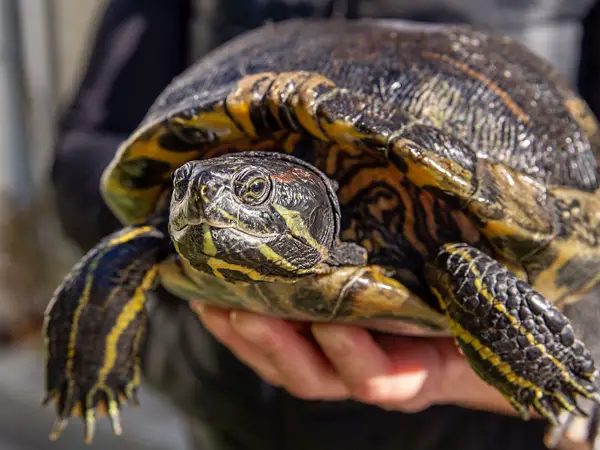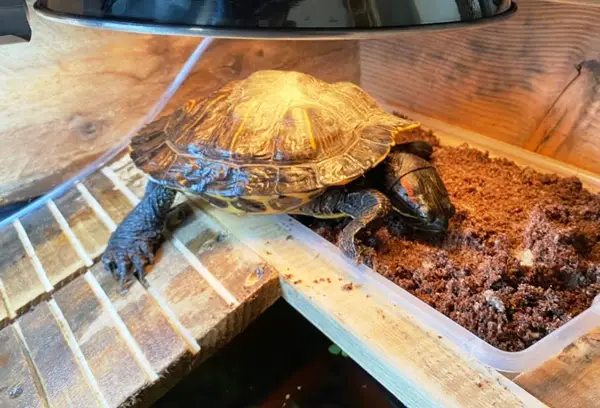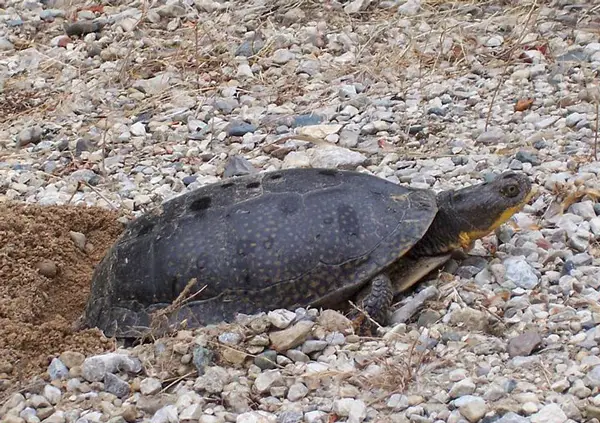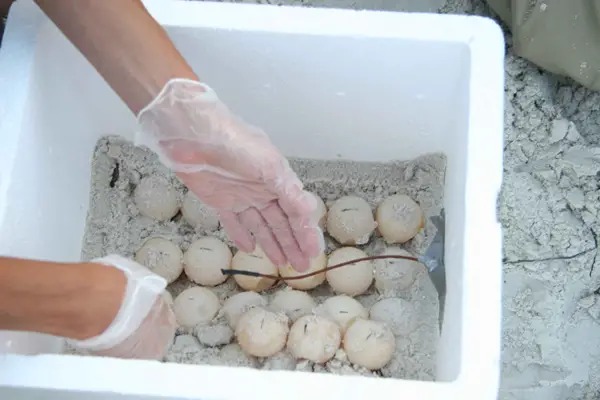How Can You Tell If a Turtle is Pregnant? What Should You Do?
The mysterious shell of turtles can hide a lot of truth. It could also hide their pregnancy. Pregnancy is hard to detect as turtles conceal their eggs under their shell.
So how can you tell if a pet turtle is pregnant? If you know your turtle inside and out, you’ll notice changes in her behavior if she gets pregnant. Some of these changes could include an unusual basking schedule (basking all the time or not at all) and trying to dig down the basking platform. You may also notice restlessness, change in the eating habit, and sporadic movement around the tank.
If you see these notable behavioral changes, try to feel her eggs by sliding the pointer finger around the stomach. You may also see a slight bump due to eggs on the plastron.
Although a turtle’s pregnancy mainly includes behavioral changes, there are also visual signs. In this article, we’ll get into all their details.
How Can You Tell If a Turtle is Pregnant?
Contents

Let’s discuss the pregnancy signs of a turtle in detail here.
Restlessness
A pregnant turtle will become restless and move around the tank randomly. You may see her trying to dig through the basking platform or the bottom of the enclosure, swimming through the tank sides, or trying to climb out of the tank to escape. All these are signs that she’s gravid and looking for a nesting site where she can release her eggs.
Change in Basking Habit
When a turtle is gravid, she usually has a change in the basking habit. You might see her basking for more than usual, maybe all the time, or she may not bask at all, even for days.

Change in the Eating Habit
A significant behavioral change is noticed in the eating habits of pregnant turtles. She’ll lose appetite and may not eat at all. You may see her busy finding a place to lay her eggs and not concentrate on food.
However, don’t be shocked if you notice the opposite reaction towards where she might be seen eating more than usual. Although it’s not a typical scenario, they might end up overeating due to mental stress.
Digging
We’ve mentioned digging in the restlessness, but it’s something that needs a separate mention. You’ll see your turtle digging in the tank’s available substrates. And if she uses her rear legs while digging, you can be almost sure that she’s carrying eggs and trying to make a suitable nesting place to lay her eggs.
Consulting with a Herp Vet to Carry Out Pregnancy Tests
After observing behavioral changes, you can consult your herp vet to conduct further pregnancy tests for assurance. Typically an expert or qualified herp vet will find out about the turtle’s pregnancy in the following ways:

Also read: Can Turtles and Frogs Live Together?
Manual Palpation
Palpating or trying to feel the eggs is the best way to confirm the pregnancy of your turtle. But it should be performed by a herp vet to avoid breaking eggs or causing yolk peritonitis. Palpating the turtle requires delicate pressing in the soft areas close to the rear legs between the carapace and plastron. For a gravid turtle, the eggs could be easily felt.
X-ray
Although carrying out an x-ray isn’t common to diagnose pregnancy in turtles, many think it’s the best way to be sure whether a turtle is gravid or not. Your herp vet will take an x-ray of your turtle to see if there are eggs present. An x-ray is helpful because it can provide a clear picture of the eggs’ status, like how many eggs are there or if there are any problematic eggs or not.
How to Help Your Pregnant Pet Turtle Lay Eggs
Aquatic pregnant turtles look for soil to make their nest and lay eggs. But for pet turtles, leaving them out in the ground can be risky; they might be lost or attacked by predators. However, you still have to manage an ideal spot for them. Otherwise, they will retain their eggs, leading to serious health issues. So what can you do?

The best idea for captive turtles is to provide a nesting box to mimic the natural environment. It’ll encourage them to oviposition or standard egg-laying method and prevent dystocia or egg-binding.
You should provide a nesting box even if you don’t plan to breed your turtle. If you’re ready to welcome new baby turtles, you can incubate the eggs; otherwise, discard them. Here’s a step-by-step guide that discusses how you can make a nesting box for your pet turtle.
Step 1: Find a Suitable Nesting Box
Choose a rubber or plastic container at least 20 gallons and 5 inches deep. Ensure the box is a minimum of twice the length and the width of the turtle, yet it can fit in your place.
Step 2: Get a Waterproof Modular Shelving
Besides a nesting box, you also need a modular shelving set. It has to be waterproof and large enough to accommodate the nesting box.
Step 3: Prepare the Nesting Box
Now prepare the nesting box by filling the container with an appropriate substrate like premium topsoil, soft sand, or sphagnum moss. Fill it to the proper depth. Ensure there are no rocks or twigs in the substrate as it can discourage digging.

Step 4: Secure the Nesting Box & Shelving
As you place the shelving and the nesting box in the aquarium, you need to secure them. You can use the aquarium-safe rocks to anchor the setup so they stay in place. Build up the rocks around the structure so there’s no underwater place where your turtle can be stuck.
Step 5: Build Up the Ramp
You must build a cork ramp, so your pet reptile can easily climb in and out of the nest. You shouldn’t conceal the box as you’ll need to handle the eggs.
Step 6: Set up the Lighting
Place a timer-controlled automatic heat lamp for the turtle. The light should come and go maintaining a schedule that’s most suitable for a pregnant turtle.
How Many Eggs Do a Pregnant Pet Turtle Lay?
The common turtle breeds that are kept as pets include box turtle, red-eared slider, painted turtle, and snapping turtle. The number of eggs they lay at once varies. The following chart depicts the number of eggs each breed can lay at once.

| Turtle Breed | Number of Eggs Laid at Once |
| Box Turtle | 5 |
| Red Eared Slider | 2 to 20 |
| Painted Turtle | 4 to 10 |
| Snapping Turtle | 20 to 40 |
How Can You Incubate Turtle Eggs?
If you’re looking to incubate turtle eggs and hatch offspring, you need to create a favorable condition so the embryo in the eggs can develop. It means you must regulate temperature and ensure the eggs don’t move too much.
The turtles naturally hatch their eggs on their own by sitting on them, which takes around two months to complete. But for turtles in captivity, you can buy a turtle egg incubator to incubate the eggs artificially.

Once the turtle has laid her eggs, you’ve to transfer them to the incubator, ensuring they’re right side up. Avoid turning them upside down to prevent embryo damage.
The ideal incubation temperature is 87 degrees Fahrenheit, so set the temperature and wait for a particular time to welcome the new baby turtle. Very few hatchlings survive, so you don’t have to worry about getting a larger tank! If your turtle has a mate and you want to raise a new turtle, then read some care guides.
Video
Check out the video here if you plan to self-test your turtle’s pregnancy.
FAQs
Check out some more FAQs related to gravid turtles here.
The incubation period for most turtles ranges between 45 to 75 days, typically 60 days that a turtle stays pregnant. You can read more about pet turtle’s incubation here.
Female turtles can develop eggs even if they haven’t mated recently. Like some animals (check out the research for more information), turtles can retain sperm for years for a mating that occurred in the past.
Related: Can You Potty Train a Turtle?
Final Words
Initially, you can know your turtle is pregnant by seeing behavioral changes like restlessness or attempting to dig or escape. The palpation technique can further confirm it, which requires using your finger to feel the eggs. If you’re unsure how to do that, consult a herp vet to do that for you. Finding out about your turtle’s pregnancy is crucial since it requires some preparation to help your turtle lay her eggs.
Otherwise, it can lead to serious health issues like dystocia and egg retention. We’ve discussed how you can get her a nesting box and waterproof modular shelving to place in her aquarium to mimic the natural environment and make her safely lay eggs. You also know how to use the incubator to hatch the eggs to welcome hatchlings. But if you don’t plan to breed, then simply discard them.


